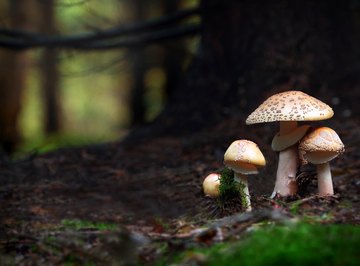
Mushroom reproduction is more accurately termed fungal reproduction, because mushrooms are the fruiting body of the fungus (plural: fungi). The body of a fungus is called the mycelial colony. It is a network of tiny filaments termed hyphae. Mushrooms are the source of spores which the fungus spreads for reproduction.
Mycelium of Fungi
The mycelium, or body, of a fungus is usually located underground. Fungal hyphae are branched filaments that somewhat resemble roots on a plant. Together the hyphae connect to spread nutrients and oxygen around the mycelium. The thin cellular walls of the hyphae also facilitate the removal of waste products.
Many species of fungi are mycorrhizal, which means they have a symbiotic relationship with the roots of plants. The plants share nutrients derived from photosynthesis with the fungi in exchange for fungal nutrients acquired from the soil. Many mother trees also use their mycorrhizal networks to share nutrients with their saplings to help them grow.
Mushrooms of Fungi
Some fungi, such as yeast, are microscopic and do not produce visible mushrooms. Fungi reproduce asexually through a process called budding. Mushrooms are grown as part of sexual reproduction in fungi. To reproduce sexually, two mycelial colonies must be near enough to join their hyphae and transfer their genetic material.
After mating, when the fungus is ready to spread its spores, hyphae grow into special arrangements to form a fruiting body called a mushroom. The mushroom is made up of a cap, gills and stalk. Each type of mushroom has a different variation of this basic structure. Mushrooms come in an immense variety of colors and patterns. Some mushrooms are edible, while others are highly poisonous to help protect their spores.
Spores of Mushrooms
The gills are the source of spores in a mushroom. Specialized hyphae produce spores so small that 1,000 or more could fit on a pinhead inside the gills. The majority of fungi use the wind to disperse their tiny spores. Some fungi use water droplets, streams or animals to spread their spores. For example, the stinkhorn fungi of the family Phallaceae produce a horrific smelling slime in their mushrooms that attracts flies. Flies eat this slime and then the spores are deposited to new locations in the flies' feces.
Because spores often die if they do not land in a suitable environment, fungi must produce large volumes of them. A single mushroom from a fungus in the phylum Basidiomycota can release more than one million spores a day. These mushrooms have two stages of dispersal. The first is powered by surface tension release, which shoots the spores out into the wind. In the second passive stage, the spores of mushrooms fall out once it has opened and are carried away into the wind.
Fungi from the phylum Ascomycota use a different approach to spore development and dispersal. While the spores of basidiomycetes are grown on external club-shaped structures called basidia, ascomycetes grow anywhere between one and 100 spores, which develop inside tubular sacs called asci. Physical pressure - like water droplets hitting the mushroom, for example - is usually required to release spores, which then shoot out of the asci by force to be carried away by the wind.
Spore Dormancy
The rate of metabolism in spores is low. Spores produced from sexual reproduction often need particular conditions to grow and may need to wait for a period of time before they develop. This is called postmaturation. Other spores require specific chemical or heat shocks to trigger germination. Asexually-produced spores typically germinate more easily and simply require the right environmental conditions.
Spore Germination
Once the spores have landed in a suitable moist environment with sufficient food, they begin to germinate. The spore enlarges as it hydrates and respiration increases, then hyphae grow out from the spore in all directions. This new growth of hyphae forms a new mycelial colony. Spore germination can take anywhere from 20 minutes up to 15 hours, but usually takes between three and six hours.
References
- Utah State University Herbarium: What Are Fungi?
- Science Learning Hub: All About Fungi
- Science Learning Hub: Fungal Life Cycles - Spores and More
- Smithsonian Magazine: Do Trees Talk to Each Other?
- The University of Arizona: Chapter 10 Fungal Spores, Spore Dormancy and Spore Disperal
- Australian National Herbarium: Australian Fungi
About the Author
Adrianne Elizabeth is a freelance writer and editor. She has a Bachelor of Science in Ecology and Biodiversity, and Marine Biology from Victoria University of Wellington in New Zealand. Driven by her love and fascination with all animals behavior and care, she also gained a Certificate in Captive Wild Animal Management from UNITEC in Auckland, New Zealand, with work experience at Wellington Zoo. Before becoming a freelance writer, Adrianne worked for many years as a Marine Aquaculture Research Technician with Plant & Food Research in New Zealand. Now Adrianne's freelance writing career focuses on helping people achieve happier, healthier lives by using scientifically proven health and wellness techniques. Adrianne is also focused on helping people better understand ecosystem functions, their importance, and how we can each help to look after them.
